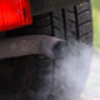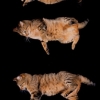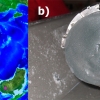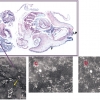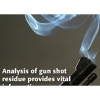Articles
Synchrotron-based micro Fourier transform infrared mapping to investigate the spatial distribution of amorphous and crystalline calcium carbonate in earthworm-secreted calcium carbonate balls
Several earthworm species secrete very small granules of calcium carbonate, and the authors think these are involved in pH regulation. These granules contain different polymorphs of calcium carbonate, including the amorphous form which is very unstable in the laboratory. To investigate this they have FT-IR spectroscopy and mapping, and are continuing this work with Ca XANES.
X-ray fluorescence for cultural heritage: scanning biochemical fingerprints in archaeological shipwrecks
Yvonne Fors, Håkan Grudd, Anders Rindby and Lennart Bornmalm tell us about “X-ray fluorescence for cultural heritage: scanning biochemical fingerprints in archaeological shipwrecks”. Two outstanding examples of the preservation of wood are the warships Vasa, in Stockholm and the Mary Rose in Portsmouth and this article looks at the role XRF has played in the preservation of the wood of both ships.
Determination of elemental distribution or heterogeneity by X-ray fluorescence
Another area of application of XRF, “Determination of elemental distribution or heterogeneity by X-ray fluorescence”, is considered by Christopher Shaffer and Didier Bonvin. The ability of modern X-ray spectrometers to perform small spot analysis as well as mapping has opened up new applications in non-homogeneous samples. The authors show applications in metals, precious alloys as well as rocks.
Strategies for ambient aerosols characterisation using synchrotron X-ray fluorescence: a review
Knowledge about the particles in the air is important because of their effect on our health and their impact on our climate through cloud formation and transport of nutrients into the oceans. Ursula Fittschen describes “Strategies for ambient aerosols characterisation using synchrotron X-ray fluorescence: a review”. This technique can provide elemental determination and speciation of aerosol particulates with limits of detection in the pg m–3 range for many elements.
Determination of trace element concentrations in ambient aerosols by synchrotron radiation-induced X-ray fluorescence spectrometry
Both the size and chemical composition of airborne particles have an effect on human health. Whilst the effects of size have been much studied, many of the toxic chemicals in particles are at very low concentration and have been less studied. Monitoring their composition and concentration over time helps to determine their source. Synchrotron radiation-induced XRF spectrometry proves to be a good tool for this purpose.
Time-resolved X-ray absorption spectroscopy
How a cat manages to turn and land on its feet may not be the most obvious start to an article in Spectroscopy Europe. However, C.J. Milne and M. Chergui use the example in their article on “Time-resolved X-ray absorption spectroscopy” to show how the time dimension is important in many analyses and applications. There has been a real surge in time-resolved X-ray absorption studies in chemistry, biology and materials science. Picosecond time resolution is routinely achieved and femtosecond resolution has been demonstrated at synchrotrons, albeit at the cost of a significantly reduced photon flux. However, the advent of hard X-ray-free electron lasers offer the promise of making such studies routine.
Local vs global climate change: investigation of dust from deep ice cores
The study of dust particles in our atmosphere is important since they can act as a suppresor of global warming. The analysis of historical levels of dust in the atmosphere through ice cores is vital in this work. Synchrotron-radiation spectroscopic techniques such as TXRF and XANES can be used to analyse extremely small amounts of dust.
Fireworks: composition and chemistry through Raman spectroscopy and SEM-EDS imaging
Whilst fireworks are a great entertainment, they can also be used for illegal activities as well as potentially containing dangerous chemicals. The combination of Raman spectroscopy and SEM-EDS turns out to be a very efficient analytical method. In fact, these complementary techniques may also be used to analyse other kinds of pyrotechnic artefacts, low explosive formulations, high explosives, explosion residues etc.
X-ray spectrometry analysis of welding fumes
Industrial environments pose potentially hazardous situations whereby workers may be exposed to various airborne toxic elements in their breathing zone. One of the main aerosol fractions of interest is welding fume, which can be determined with XRF spectrometry.
The use of complementary techniques in understanding the detoxification of aluminium in the freshwater snail, Lymnaea stagnalis
The authors describe the use of a range of complementary methods to explore cellular, physiological and behavioural mechanisms underlying Al accumulation and toxicity, and its eventual fate, using the pond snail as a model organism.
Integrated analytical techniques for the characterisation of environmental particles
Information on the detailed chemical composition, structure and morphology of environmental particles, and especially airborne particulate matter (PM), facilitate the understanding of their reactivity, sources, transport and changes of chemical species and, hence, prediction of their likely impact on the environment and human and animal health. The analysis techniques for environmental particles can broadly be divided into two groups: bulk (for example, water-soluble ionic content by means of ion chromatography for PM, elemental concentrations by means of X-ray fluorescence spectrometry for all environmental particles, chemical structural information by means of X-ray diffraction for larger environmental particles, such as sediments and sands etc.) and micro-analytical techniques, whereby the character of any single particle can be probed.
Micro-XRF sediment core scanners: important new tools for the environmental and earth sciences
Non-destructive, high resolution, sediment core scanners incorporating X-ray fluorescence (XRF) spectrometry are now widely used by sub-disciplines in the earth and environmental sciences and have revolutionised the analysis of sediment cores. These powerful instruments allow the cores to be analysed rapidly with virtually no sample preparation. They can record along-core variations for many elements in the Periodic Table from Al to U and detection limits down to a few ppm can be achieved in favourable conditions depending on the acquisition dwell time.
Complementary spectroscopic analyses of varnishes of historical musical instruments
For the past two centuries, the nature of the varnishes coating historical instruments has been a much debated subject. Focusing in particular on the varnishes used for coating violins made by the Italian instrument-maker Antonio Stradivari, numerous hypotheses have been raised by instrument-makers, experts, musicians and chemists, without reaching a general understanding of the ancient varnishing techniques. A few years ago, we decided to work on this topic using several complementary approaches for materials characterisation and study of historical sources (ancient varnish recipes, etc.).
Trace element analysis of urban aerosol particles using X-ray fluorescence spectrometry
In urban environments, where the majority of the human population lives, air pollution is a major threat to human health. In many countries and regions of the world, this has led to the implementation of regulations to control the emissions of air pollutants and limits for the allowed concentrations of different types of air pollutants. The limits are set at levels at which harm to the health may occur if the limits are exceeded. One of these pollutants is aerosol particles. In most cases, the environmental quality standards limit is set to a certain mass concentration of particles of a certain size.
Forensic applications of X-ray fluorescence microscopy
Spectroscopy plays a vital role in the forensic scientist’s task to analyse crime scene evidence. A new and emerging technique within the forensic field is X-ray fluorescence (XRF) microscopy.
X-ray fluorescence applications to art and cultural heritage: study of a Japanese print
Scientific studies of artworks are an important practice in many institutions dedicated to the study and protection of cultural heritage. Applied physics and chemistry provide the scientific data necessary to characterise and understand the origin, the degradation processes and the environment in which the artwork was created or has existed.
X-ray fluorescence in medicine
The ultimate use of XRF for medical analysis is in vivo measurements made directly in the living patient or volunteer. It started with quantitative analysis of iodine in the human thyroid. The idea sprang from the pioneering work by Jacobsson, who developed a technique for subtraction radiology of iodine using two x-ray energies, one above and one below the K-absorption edge of iodine. Hoffer et al. realised that if that technology worked, there should be a chance to see the emitted characteristic x-rays from iodine using the semiconductor detectors, which at that time had been developed for nuclear and particle physics. In this way the first in vivo XRF analysis was done, quantifying the iodine concentration in human thyroid, typically around 400 µg g–1. The further development of the in vivo XRF technique was related to the analysis of heavy elements, first covering lead and later cadmium and to some extent also mercury in occupationally exposed workers. Platinum was also analysed to investigate uptake and kinetics of the cytostatic agent cis-platinum in tumour patients. The following section describes efforts made to study various toxic elements in vivo in occupationally exposed workers and in patients.
X-ray fluorescence trace metal analysis of environmental liquid samples after membrane preconcentration
One of the dangerous kinds of pollution in aquatic systems is due to the dumping of materials containing heavy metals. Hence, the monitoring of heavy metals in aqueous samples is becoming increasingly important. Normally, metal concentrations in water are in the ng L–1 range, and the analytical procedures used for their determination are usually based on Anodic Stripping Voltametry (ASV) and Atomic Spectrometry, including Electrothermal Atomic Absorption Spectrometry (ETAAS), Inductively Coupled Plasma Atomic Emission Spectrometry (ICP-AES) and Inductively Coupled Plasma Mass Spectrometry (ICP-MS). However, the direct analysis of some complex environmental samples like seawater presents some difficulties, mainly due to the high salinity of the matrix. Therefore, in such cases, a dilution of the sample may be necessary before the analysis, or a preliminary separation and/or preconcentration step may be required to eliminate interferences and/or to improve detection limits for metals in the low µg L–1 range. Moreover, when the analysis is performed by using solid sorbents followed by spectrophotometric techniques, an additional elution step after the preconcentration procedure is necessary to recover the species in an appropriate medium.
X-ray fluorescence spectrometry for trace element analysis of vegetation samples
X-ray fluorescence spectrometry could be a good analytical tool for trace metal analysis of vegetation samples as an alternative to classical destructive methods, given that it provides accuracy and precision fulfilling the requirements for environmental studies.
Micro-X-ray studies of the Godarville speleothems
Andrzej Kuczumow,a Dominique Genty,b Pierre Chevallier,c Jakub Nowak,a Marek Floreka and Anna Lincaa
aDepartment of Chemistry, Catholic University Lublin, 102 Al.Kras´nicka, 20-718 Lublin, Poland
bLaboratoire des Sciences du Climat et de l’Environnement, LSCE UMR CEA/CNRS 1572, Bât. 701, L’Orme des Merisiers, CEA Saclay, 91 191 Gif sur Yvette Cedex, France
cLURE, Campus Universitaire Paris-Sud, Bât. 209D, 91898 Orsay Cedex, France





